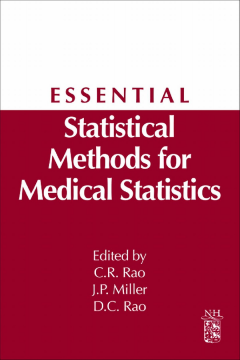
Additional Information
Book Details
Abstract
Essential Statistical Methods for Medical Statistics presents only key contributions which have been selected from the volume in the Handbook of Statistics: Medical Statistics, Volume 27 (2009).
While the use of statistics in these fields has a long and rich history, the explosive growth of science in general, and of clinical and epidemiological sciences in particular, has led to the development of new methods and innovative adaptations of standard methods. This volume is appropriately focused for individuals working in these fields. Contributors are internationally renowned experts in their respective areas.
· Contributors are internationally renowned experts in their respective areas · Addresses emerging statistical challenges in epidemiological, biomedical, and pharmaceutical research · Methods for assessing Biomarkers, analysis of competing risks · Clinical trials including sequential and group sequential, crossover designs, cluster randomized, and adaptive designs · Structural equations modelling and longitudinal data analysis
"Essential Statistical Methods for Medical Statistics (hereafter ESMMS) is a shortened version of The Handbook of Statistics, Volume 27 (hereafter HS27; Rao, Miller, and Rao 2008), also edited by Drs Rao, Miller, and Rao. ESMMS contains a collection of review chapters written by renowned researchers in statistics (11 of the original 27 chapters from HS27), with the aim of providing a suitably broad, yet concise, survey of traditional and emerging topics in biomedical statistics. ESMMS is targeted to applied statisticians, with an emphasis on applications-oriented methodology. Most chapters proceed in a gentle introductory manner, but do presume a general familiarity with calculus, probability theory, and statistical modeling (random variables, likelihood functions, maximum likelihood estimation, etc.) at the level of a graduate course in biostatistics… In summary, I do believe ESMMS achieves its basic goal of providing an approachable general reference for applied statisticians. Virtually the entire text is well written, and it covers most of the material one would expect to find in such a volume. However, my own preference is for more targeted material (with specific code examples). As I sit at my desk writing this review, I am able to point to a targeted textbook for each and every chapter of ESMMS lying on the single bookshelf above my computer. In addition, while ESMMS does provide a slightly more technical treatment (and is obviously more current) than an entry-level biostatistics text, such as Fisher and Van Belle (1993), it is not clear to me whether this brings a great deal of added benefit. With that said, my recommendation for the applied statistician in search of a one-stop overview of biostatistics would be to spend the extra money and get HS27. While it is almost triple the cost, I would hazard to guess that it would be more useful, given the extensive amount of material it covers."--The American Statistician, May 2012, Vol. 66, No. 2
